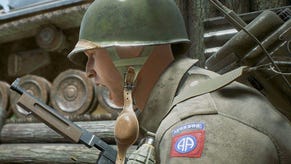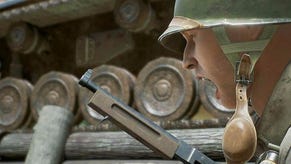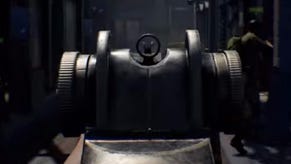Battalion 1944 succeeds in stripping away the clutter of the modern FPS
Boomer generation.
Battalion proclaims itself to be a stripped down, tackle-out, "old-school" multiplayer shooter. I find this an interesting statement, as to me old-school means rocket-jumps, glistening gibs and mind-bending level design - aka games that graduated with a first from the University of John Romero. Battalion, on the other hand, studied at Zampella polytechnic, as evidenced by the khaki browns and Wehrmacht greys, minimalist puffs of gore, and the presence of a prone key. Lesson number one, Battalion, nobody lies down in an old-school shooter unless they're dead. Now, onto nailgun aesthetics and implementation...
The key clarification here is that Battalion is an old-school World War Two shooter. At a basic level, this means "like the original Call of Duty multiplayer but with anti-aliasing." Yet the situation isn't quite that simple. Hidden behind Battalion's bullet-peppered Norman hedgerows are shades of Counter-Strike and Day of Defeat. It's a multiplayer shooter that hopes to cater both to simple arcade pleasures and more dedicated eSportsy types, rewarding skilful and measured play as much as it does bunny-hopping and pneumatic wrist-joints.
This isn't some incisive observation on my part. It's precisely how the beta was presented, offering both an "arcade" component that cycled between three maps and and three modes (the latter being team deathmatch, domination, and capture-the-flag) alongside a fourth, ranked mode called Wartide that offered a slight variant of Counter-Strike's bomb-defusal shenanigans. In both cases, players were split into two teams of five, assuming the role of either an allied or axis soldier, and could select from a range of weapons that includes rifles, sniper-rifles, sub-machine guns, or shotguns.
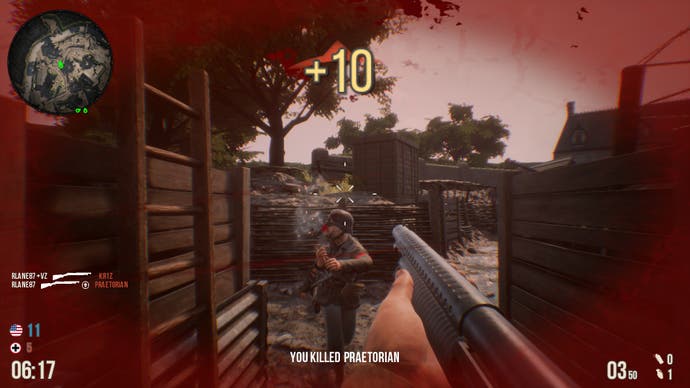
I found Battalion to be immediately appealing in two ways. Firstly, it does an excellent job of expunging all the clutter that seems to come packaged with multiplayer shooters these days. There's no need to learn an epic novel's worth of characters and their associated abilities, strengths, weaknesses, personal history, next of kin, allergies and intolerances, and whether they take milk and/or sugar in their tea. Neither is there a labyrinthine web of perks, unlocks or star cards to decipher like some ancient hieroglyphic dialect. You pick your team, you pick your gun, and that's it.
The other point in Battalion's favour is its WW2 guns feel great. In visual and audio design, they're spot on; from the iconic "ping" of an M1 Garand's clip ejecting its last round, through the ominous snap of a Springfield sniper rifle, to the mechanical rattle of the German MP40, each weapon feels satisfying to wield in its own way. They're also smartly balanced in terms of power and situational effectiveness. The Thompson, for example, is a great all-rounder that can potentially win out in any situation, but is less effective than a rifle at long range or a trench gun at short. The only gun that seemed poorly implemented was the BAR, which is cumbersome and unwieldy, especially compared to its German equivalent the lighter, more precise ST44.
It's been a long time since I played the original Call of Duty multiplayer, but compared to its modern equivalent, which conveniently returned to its old stomping ground last year, Battalion is a more pared down, more tense than intense WW2 shooter. The restriction to ten players means combat occurs in little, sparky pockets rather than being a constant, cacophonous roar. Sprinting blindly around the map is discouraged, as there's a momentary delay in readying your weapon when returning to normal speed.
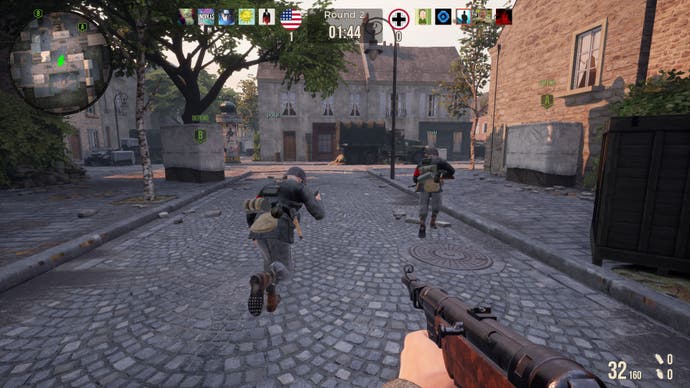
In addition, your health-bar is small and fragile, only able to sustain one or two hits before the camera cuts to spectating another player and the respawn countdown starts. This way, Battalion encourages a more thoughtful and considered approach to combat, creeping steadily forward, ideally with a squadmate in tow, watching your angles and listening out for enemy footsteps when nearing the corner of a trench or building.
What isn't discouraged, sadly, is leaping from around a corner like a weaponised kangaroo, which every other player in the beta seemed to be doing by the end of the weekend, rather making a mockery of Battalion's otherwise fairly smart and sensible WW2 shootery. Personally, I'd take the opportunity to excise this more egregious element of post-millennium shooters and ditch the jump key entirely, replacing it with a mantle ability for those situations where clambering over an obstacle is required. I'll accept bouncing around like a loon in Quake. But as we already discussed, Battalion ain't Quake.
Like much else in the game, the maps on show were standard WW2 fare. Battery takes inspiration from the battle at Brecourt Manor, combining a network of trenches with a hedge-lined dirt track that runs around the circumference of the map. Meanwhile, Coastal is essentially Carentan-by-the-sea (or should that be par-la-mer?), an idyllic French village with an open, sniper-friendly courtyard ringed by narrow side-streets and twisting alleyways.
The maps are fine, apart from an issue on Coastal where the Axis players could easily box the Allied forces into their spawning area. Yet while I'm aware Bulkhead Interactive have to work from a limited palette, I hope there will be maps that explore World War 2 beyond the gospel according to Spielberg. There are hints of this in the third map - Derailed - which centres around a tram-crash in a stone-built town and includes both a bombed-out cinema and a church you can fight inside, but it's still not quite stepping off the Band of Brothers carousel that gaming has been riding for the best part of 20 years.

More generally, while I think Battalion is a perfectly serviceable and admirably stripped-down multiplayer shooter, I also fear it's currently lacking a spark. At times it feels a little too understated for its own good. Explosions and bullet decals are somewhat underwhelming, and in certain areas - particularly building interiors - the levels look like they've been rendered with a 2003 engine.
A more pressing concern is the lack of a unique or defining game-mode. The main competitive-mode, Wartide, follows the same format of Counter Strike - featuring short rounds that can be won by either killing all the other team or detonating/defusing a bomb - but with a slightly different method of doling out weapons. Each player can choose either a default loadout or a limited number of specialised loadouts. If you die carrying a specialised loadout, it can be stolen by the other team, increasing their pool for that loadout while decreasing yours.
Again, this works fine, but it nonetheless feels somewhat staid. Perhaps this is an inevitable consequence of going back to one's perceived roots; it's tough to innovate while looking over your shoulder. Then again, Battalion is only in beta, and who knows what else developers Bulkhead Interactive have squirrelled away in its bunker.
Either way, there's undoubtedly merit in the notion of disrobing the FPS of its accumulated finery, and a renewed focus on the unholy trinity of move, point, shoot. It also feels pretty darned good to play, which is a great starting point. I just hope that, by the time of its full release, Battalion has learned to be more comfortable in its own uniform. It's a decent WW2 shooter, but if it wants to be the World War II shooter, it needs to do more than simply hark back to the past. It needs to put its own stamp on it in a more definite fashion.



